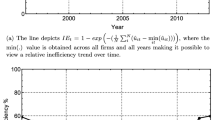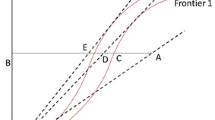Abstract
A two-stage approach is used in a stochastic frontier analysis of the factors affecting hospital efficiency. In the first stage, a translog cost-function is used to estimate inefficiency scores. In the second stage, inefficiency scores are regressed against independent variables to test hypotheses that come from X-inefficiency Theory. The study was based on 1989 data for 195 Pennsylvania acute care hospitals. This data base was chosen because of the availability of patient-level severity of illness data, a measure of output that is not available from most data sources. The stochastic frontier analysis models estimated mean inefficiency scores that ranged from 0.075 to 0.180. The addition of the DRG case mix index (CMI) reduced estimated inefficiency by more than 50%. The incremental effect of a severity of illness variable to an equation with CMI was very small. The second-stage results suggest inefficiency and are inversely associated with regulatory pressures and industry concentration.
Similar content being viewed by others
REFERENCES
ProPAC., Prospective Payment Assessment Commission Report and Recommendations to the Congress. ProPAC, Washington, D.C., 1995.
Aaron, H., Serious and Unstable Condition: Financing America's Health Care, Brookings Institution, Washington, D.C., 1991.
Rosko, M.D., Measuring technical efficiency in health care organizations. J. Med. Syst. 14(4):307–22, 1990.
Farrell, M.J., The measurement of productive efficiency. J. Roy. Stat. Soc. Series A Gen. 120(3):253–281, 1957.
Aigner, D., K. Lovell, and Schmidt, P., Formulation and estimation stochastic frontier production models. J. Econometr. 6:21–37, 1977.
Hofler, R.A., and Folland, S.T., Technical and Allocative inefficiencies of United States hospitals under a stochastic frontier approach. Presentation at the Midwest Economics Associations Fifty-Fifth Annual Meeting, St. Louis, MO, 1991.
Zuckerman, S., Hadley, J., and Iezzoni, L., Measuring hospital efficiency with frontier cost functions. J. Health Econ. 13:255–80, 1994.
Grannemann, T.W., Brown, R.S., and Pauly, M.V., Estimating hospital costs: A multiple-output analysis, J. Health Econ. 5(2):107–127, 1986.
Cowing, T.G., and Holtmann, A.G., Multiproduct short-run hospital cost functions: Empirical evidence and policy implications from cross-section data. South. Econ. J. 49(3):637–653, 1983.
Rosko, M.D., and Broyles, R., The Economics of Health: A Reference Handbook, Greenwood, New York, 1988.
Newhouse, J., Frontier estimation: How useful a tool for health economics? J. Health Econ. 13(3):317–322, 1994.
Rosko, M.D., and Carpenter, C.E., Development of a scalar hospital-specific severity of illness index. J. Med. Syst. 17(1):25–36, 1993.
Leibenstein, H., Beyond Economic Man. Harvard University Press, Cambridge, 1976.
Lovell, C.K., Production frontiers and productive efficiency. In: Fried, H.O., Lovell, C.K., and Schmidt, S.S., editors. The Measurement of Productive Efficiency. Oxford University Press, New York, 1993, pp. 3–67.
Charnes, A., Cooper, W., Lewin, A., and L. Seifford, eds., Data Envelopment Analysis: Theory, Methodology and Applications. Kluwer, Boston, 1994.
Timmer, C., Using a probabilistic frontier production function to measure technical efficiency. J. Pol. Econ. 79(4):776–794, 1971.
Nyman, J., and Bricker, D., Profit incentives and technical efficiency in the production of nursing home care. Rev. Econ. Stat. 71(3):586–594, 1989.
Vitaliano, D.F., and Toren, M., Hospital cost and efficiency in a regime of strict regulation. East. Econ. J. 22(2):161–175, 1996.
Burgess, J., and Wilson, P., Variation in inefficiency among U.S. hospitals. INFOR 36(3):84–102, 1998.
Garnick, D.W., Luft, H.S., Robinson, J.C., and Tetreault, J., Appropriate measures of hospital market areas. Health Serv. Res. 22:69–89, 1987.
Greene, W.H., LIMDEP: User's Manual and Reference Guide. Econometric Software, Inc., Bellport, N.Y., 1991.
Jondrow, J., Lovell, K., Materov, I., and Schmidt, P., On the estimation of technical inefficiency in the stochastic frontier production function model. J. Econometr. 19:233–8, 1982.
Christensen, L.R., Jorgenson, D.W., and Lau, L.J., Transcendental logarithmic utility functions. Am. Econ. Rev. 65(3):367–383, 1975.
Rosko, M.D., DRGs and severity of illness measures: An analysis of patient classification systems. J. Me.l Sys. 12(4):257–74, 1988.
Iezzoni, L.I., Ash, A.S., Cobb, J.L., and Moskowitz, M.A., Admission MedixGroup score and the cost of hospitalizations. Med. Care 26(10:1068–80, 1988.
Rosko, M.D., Chilingerian, J.A., Zinn, J.S., and Aaronson, W.E., The effects of ownership operating environment, and strategic choices on nursing home efficiency. Med. Care 33(9):1–20, 1995.
Rosko, M.D., All-payer and rate-setting and the provision of hospital care to the uninsured: The New Jersey experience. J. Health Polit. Policy Law 15(4):815–831, 1990.
Diehr, P., Madden, C., Cheadle, A., et al., Estimating county percentages of people without health insurance. Inquiry 28(4):413–19, 1991.
Rosko, M.D., and Carpenter, C.E., The impact of severity of illness on hospital profits: Implications for payment reform. J. Health Polit. Policy Law 19(4):729–52, 1994.
Sloan, F.A., Feldman, R.D., and Steinwald, A.B., Effects of teaching on hospital costs. J. Health Econ. 2(1):1–28, 1983.
Thorpe, K.E., The use of regression analysis to determine hospital payment: The case of Medicare's indirect teaching adjustment. Inquiry 25(2):219–31, 1988.
Caves, R.E., Industrial Efficiency in Six Nations, MIT Press, Cambridge, 1992.
Leibenstein, H., Inside the Firm: The Inefficiency of Hierarchy, Harvard University Press, Cambridge, MA, Cambridge, 1987.
Leibenstein, H., Inflation, Income Distribution and X-efficiency Theory, Croom Helm, London, 1980.
Author information
Authors and Affiliations
Rights and permissions
About this article
Cite this article
Rosko, M.D., Chilingerian, J.A. Estimating Hospital Inefficiency: Does Case Mix Matter?. Journal of Medical Systems 23, 57–71 (1999). https://doi.org/10.1023/A:1020823612156
Issue Date:
DOI: https://doi.org/10.1023/A:1020823612156




